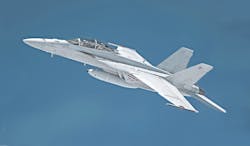Navy asks Boeing to make final procurements of airborne infrared sensors for stealthy Super Hornet attack
PATUXENT RIVER NAS, Md. – U.S. Navy air combat experts are asking electro-optics engineers at the Boeing Co. to procure 19 airborne infrared search and track (IRST) systems to help Navy combat jets detect enemy aircraft without using radar.
Officials of the Naval Air Systems Command at Patuxent River Naval Air Station, Md., have announced a $43.5 million order to the Boeing Defense, Space & Security segment in St. Louis to procure the 19 IRST pods, 15 supply IRST pod spare parts, 34 fuel tank assemblies, 34 sensor assembly structures, and special tooling, non-recurring engineering, sustainment support, and data.
These infrared sensor avionics will go aboard Navy aircraft like the Boeing F/A-18E/F Super Hornet carrier-based jet fighter-bomber. The Lockheed Martin Missiles and Fire Control segment in Orlando, Fla., designs the IRST, which enables the F/A-18E/F to detect, track, and attack enemy aircraft without making its presence known.
The Super Hornet combat aircraft IRST is a long-wave infrared detection sensors system that targets enemy aircraft in conditions where the Super Hornet cannot use its radar.
The system uses infrared search and track technology to detect and provide weapons-quality track solutions on potentially hostile aircraft. The Navy and Boeing first flew the IRST Block II pod on an F/A-18E/F Super Hornet in late 2019. IRST is a passive, long-range sensor incorporating infrared and other sensor technologies for accurate targeting.
This order represents the final IRST pod assemblies for the U.S. Navy, officials say.
The IRST Block II gives the F/A-18 improved optics and processing power, significantly improving pilot situational awareness, Boeing officials say. The Block II variant will be delivered to the US Navy in 2021, reaching initial operational capability shortly thereafter.
The IRST Block II is part of the Super Hornet Block III upgrades to keep the F/A-18 in active service for decades to come. Block III upgrades also include enhanced network capability, longer range with conformal fuel tanks, an advanced cockpit system, signature improvements, and an enhanced communications system.
The IRST fits on the front of the Super Hornet's centerline fuel tank. Three years ago Navy leaders approved a restructured program that foregoes full-rate production of Block I sensors and proceeds directly to the Block II system.
The IRST passive search system consists of a passive longwave infrared receiver, a processor, inertial measurement unit, and environmental control unit. The infrared receiver, processor, and inertial measurement unit fit inside the sensor, which attaches to the front of the fuel tank mounted to the aircraft on the BRU-32 bomb rack.
The Navy developed the IRST Block I using components from the F-15K/SG aircraft's infrared receiver, which is based on the IRST design of the now-retired Navy F-14 Tomcat jet fighter. IRST Block II includes improvements to the infrared receiver and updated processors. The Navy intends to produce 170 IRST systems.
Even amid electronic attack or heavy RF and infrared countermeasures, IRST provides autonomous, tracking data that increases pilot reaction time, and enhances survivability by enabling first-look, first-shoot capability, Lockheed Martin officials say.
Infrared sensors like the IRST detect the heat from an aircraft's engine exhaust or even the heat generated by the friction of an aircraft as it passes through the atmosphere. Unlike radar, infrared sensors do not emit electronic signals, and do not give away their presence to adversaries.
This ability can enable Super Hornet pilots to identify enemy aircraft at long ranges, and enable them to fire their air-to-air missiles at their maximum ranges.
Data from the IRST system can stand alone or fuse with the Super Hornet's other on-board sensor data situational awareness. Lockheed Martin also is developing an IRST pod that can be fitted to the F-15C and F-16 jet fighters.
On this order Boeing will do the work in St. Louis, and should be finished by April 2026. For more information contact Boeing Defense, Space & Security online at www.boeing.com/company/about-bds, Lockheed Martin Missiles and Fire Control at www.lockheedmartin.com, or Naval Air Systems Command at www.navair.navy.mil.
About the Author
John Keller
Editor-in-Chief
John Keller is the Editor-in-Chief, Military & Aerospace Electronics Magazine--provides extensive coverage and analysis of enabling electronics and optoelectronic technologies in military, space and commercial aviation applications. John has been a member of the Military & Aerospace Electronics staff since 1989 and chief editor since 1995.
